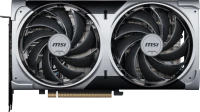TOP 5 high-end graphics cards from the NVIDIA RTX 20 family
We independently test the products and technologies that we recommend.

In this table, you can compare the video cards from the review in detail. And on the link you will find the entire catalog of video cards.

There are three categories of gaming video cards in the new MSI model range:Aero, Ventus and Gaming. The first one is the youngest and is designed for ITX cases, the company calls the second one optimal (meaning the price—performance ratio), and the third one is already an uncompromising solution with an upgraded cooling system, LED backlight and decent factory acceleration. It is the latter that will be discussed now.
There is no trace of the reference design here. The height of the graphics card has increased, the power supply phases of the core and memory have been added (there are 10 of them in total), a set of RGB LEDs with support for the proprietary Mystic Light Sync system has appeared. Instead of the basic cooling system, here we see a variation of the well-proven Twin Frozr VII system with wavy radiator fins and the desired fan blades. The system turned out to be efficient (during overclocking, the core temperature does not exceed 76 °C) and quiet (31 dB during overclocking). If the core temperature does not exceed 60 °C, then the fans stop completely — in 2D mode it is quiet, like a trained ninja.
The characteristics also differ from the standard version of RTX 2060: the core frequency has increased by 40 MHz (only 1830 MHz). By manual overclocking, an additional 95 MHz can be squeezed out of the core, resulting in an overall 6.5% performance gain in games. If we go from dry numbers to real examples, then with 4K resolution and Ultra graphics settings in "Assassin's Creed Origins", this card will give out an average of 38 FPS. If we lower the resolution to the usual FullHD, we get about 84 FPS. This is 60% faster than the previous generation GeForce GTX 1060 card.

By name, the GeForce RTX 2070 graphics card can be called the successor to the GeForce GTX 1070, but since NVIDIA has changed the hierarchy and raised the video cards a notch higher, the novelty is best compared with the GTX 1080. In terms of architecture, the core has become more complex, the number of transistors has increased by a third and the crystal area has increased. Also, in comparison with the GTX 1080, the bandwidth of GDDR6 video memory, which this model has 8 GB, has increased by 40%. In terms of power, this means that the graphics card will be enough for Ultra+FullHD quality in any modern game and Ultra plus 2.5K in almost every one.
As for the Gigabyte model, it has several interesting features. The manufacturer promises minimum overclocking to 1620 MHz, which corresponds to the specifications of the usual GeForce RTX 2070. However, in fact, the frequencies easily rise to 1785 — 1800 MHz. And with manual overclocking, you can squeeze out all 2000 MHz. The trick is that manual and automatic overclocking of the video core rest against the power consumption limit, which according to the passport is 175 watts. However, programmatically it can be raised to 200 watts, thereby obtaining a decent performance gain.
Secondly, the card is equipped with RGB backlight with support for Gigabyte RGB Fusion synchronization. Usually, the company used to use backlighting only in the top product lines of its products, although the Windforce series refers to basic-level products. Plus, the cooling system works convincingly here: in idle mode, the graphics card becomes silent due to the fans stopping, under load it is one of the quietest models in the RTX series. Despite all this, the price of the card remained at the level of the base RTX 2070.

A couple of years ago, gamers regularly complained about Palit video cards for a bunch of different reasons — from price tags to controversial quality. The company heard them and worked on the mistakes, as a result of which the GTX 10xx line from Palit became, if not a popular hit, then at least very successful. Now we will talk about the new RTX 2080 Super JetStream, which is a mid-level model, located between low-cost GamePro and top GameRock.
Compared to the reference graphics card, the RTX 2080 Super JetStream design has been redesigned to zero. The colour scheme has remained the same, but the shape of absolutely all elements of the cooling system has been changed. RGB backlight has been added, which can be configured to work in several modes. For example, change the colour depending on the heating of the core. But there is no proprietary synchronization with other RGB elements in the case.
As with many RX series cards, the cooling system is quiet and efficient. Although, no, it is actually silent here. The main difference from the brethren is that the backplate here acts not just as a stiffener, but complements the cooling system. It comes into contact with the printed circuit board in its hottest areas through thermal pads and helps to dissipate the heat generated by the video memory and the power subsystem. Even during acceleration, the core temperature did not exceed 67 °C. Moreover, we are talking about a rather serious overclocking of the core to 2115 MHz.
Therefore, the RTX 2080 Super JetStream can be recommended to those users who pay special attention to the choice of hardware for the system and do not like to pay extra. The main thing is to take into account its dimensions, because of the redesigned cooler, the card occupies almost 3 slots.

Inno3D GeForce RTX 2080 X2 OC has absorbed the best practices of the basic version of RTX 2080, rethought them and gave them a new sauce. Firstly, the card has become almost 10% cheaper than the reference sample. Secondly, the power supply system has completely changed — it has become quieter, more efficient and turns off in idle time, making the card noiseless. Thirdly, a large and comfortable gaming mouse pad was placed as a gift to the card. A trifle, but nice.
In comparison with the reference sample, the RTX 2080 version from Inno3D operates at an increased frequency of 1515 MHz, and in Boost mode it reaches 1755 MHz. With manual overclocking, it is possible to squeeze an additional 140 MHz out of the core, and 188 MHz out of memory. In overclocked mode, the core temperature reaches 75 °C, and the noise level is kept at an average level. However, here you can cheat and, after playing a little with the Power Limit settings, make it quieter and colder, practically without losing performance.
An additional plus for many gamers will be the fact that Inno3D did not change the design of the printed circuit board, so if necessary, you can safely install water cooling on it and drive the core to the limit. With all this, the Inno3D GeForce RTX 2080 X2 OC card does not have any obvious drawbacks, in game tests it looks decent against the background of more expensive versions of RTX 2080, but at the same time its price tag is lower than the recommended price from NVIDIA.

The 2080Ti is the best sports car in NVIDIA's elite garage. If this is not enough, then the Republic Of Gamers version (or just ROG) fromAsus is one of the best, most powerful and expensive variations of this graphics card. It is characterized by a unique printed circuit board with an enhanced power subsystem, a redesigned cooling system, serious overclocking potential and 11 GB of video memory.
The heart of the hero of the review was the TU102-300A-K1-A1 GPU, which includes 4352 shaders, 88 rasterization blocks and 272 texture blocks and has a high potential for overclocking. In normal mode, the core operates at a frequency of 1350 MHz, and in boost it rises to 1560 MHz. Manually, you can squeeze an additional 120 MHz from the core and another 215 MHz from above to the memory frequency. In addition to the GPU, it is worth saying thanks to the most powerful 19-phase power subsystem and a cooler.
The card from Asus uses the crown of kulerostroenie: there are three fans with unusual limiter rings, a two-section radiator, a nickel-plated plate instead of direct contact, a support frame made of thick aluminium. Everything works damn quiet and efficiently giving out a maximum of 67 °C with powerful manual acceleration. Along the perimeter, the cooler is surrounded by LED elements with support for Aura Sync backlight synchronization. However, all this stuff turned out to be massive and takes up almost 3 slots. Also note an additional bonus — the BIOS button on the end of the card, which allows you to switch the card between the "Performance" and "Silent operation" modes if necessary.
The main disadvantage of this card, which is excellent in all respects, is its price. $1,500 is serious money. Compared to the previous NVIDIA flagship, the novelty in games gives an average increase of 20-25% (or 30-35% when working with graphics), but it costs on average twice as much as the average 1080 Ti. In the future, this will pay off due to hardware processing of DLSS smoothing and ray tracing, but so far there are very few games with their support ("Battlefield 1" and "Metro: Exodus)". Therefore, in the case of the RTX 2080 Ti ROG-STRIX, you can paraphrase the Pareto principle: you have to overpay as much as possible for maximum power.
Ovens with a body height of 45 cm, which require less space for embedding in the kitchen.
"Two-wheeled citizens" with understated frame geometry, addressed to riders of the fair sex.
A modern replacement for the classic karemat, they are softer, more comfortable and more functional.
A selection of ambitious cameras of the initial-middle class, devoid of a mirror in the design of the optical part.
The best network storage with support for two hard drives and a rich functional set.
































